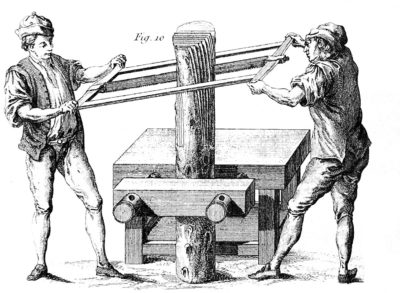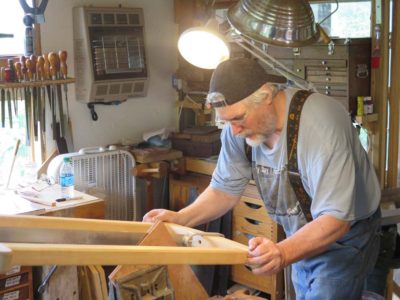Waiting For Roubo

There seems to be a growing interest in frame saws of the kind that Roubo illustrates in Plate 278. I made a smaller scale version of the tool being wielded here, and purchased two full-sized four-foot versions of c.1800 vintage.
And now there is the continuing tale of The Accidental Woodworker creating his own frame saw based on the kit supplied by Isaac Smith of Blackburn Tools, and I had recent lengthy conversations about the Roubo frame saw with Mark Harrell of Bad Axe Tools. There are of course many other iterations of the tool at work in the shops of Mike Siemsen and Shannon Rogers, and probably many others.
Recently while preparing some stock for my current project I employed my best frame saw, the one with about an eight-inch frame width and a four-foot-long hand forged blade. The piece being prepped presented a fascinating quandary in that it was 1-1/4″ thick (it is vintage piece of tulip polar that was probably once used as a kitchen table top) and what I needed was a finished thickness of 3/4″. I do not possess a bandsaw nor planer of adequate size to re-saw or thin the 20″-wide board, so the choices available to me were 1) try to connect up with the two guys in the county who own 24″ planers, 2) attack it with scrub and fore planes myself and make the extra half-inch thickness into literally bushels of shavings, or 3) try to re-saw it with either my 3-1/2 t.p.i. hand saw or my four-foot 4 t.p.i. frame saw. I chose Door #3.


Both the frame saw I fabricated and the hand saw (here seen sawing some mahogany crotch veneer) cut the 150-year-old tulip poplar like butter, but they were not long enough to work the full width of the board easily.

So I wound up using the long frame saw, which handled the task without trouble. First I spent a little time tuning up the blade, which I had not done since buying the saw at Martin Donnelly’s annual July toolapalooza a couple summers ago. Then I got to work. I would first use the saw in the pushing direction from one side, then after a few minutes move to the other end and pull it for a while. The actual sawing is not too difficult, but controlling such a long frame saw is tiring. It took me about two hours (with frequent rest breaks) to cut the nearly 3 feet of board, which would have gone much more quickly had Roubo or someone else shown up to grab the other end of the saw.

In the end the result was remarkably acceptable, especially given my lack of time in service behind the controls of this machine.


Join the Conversation!